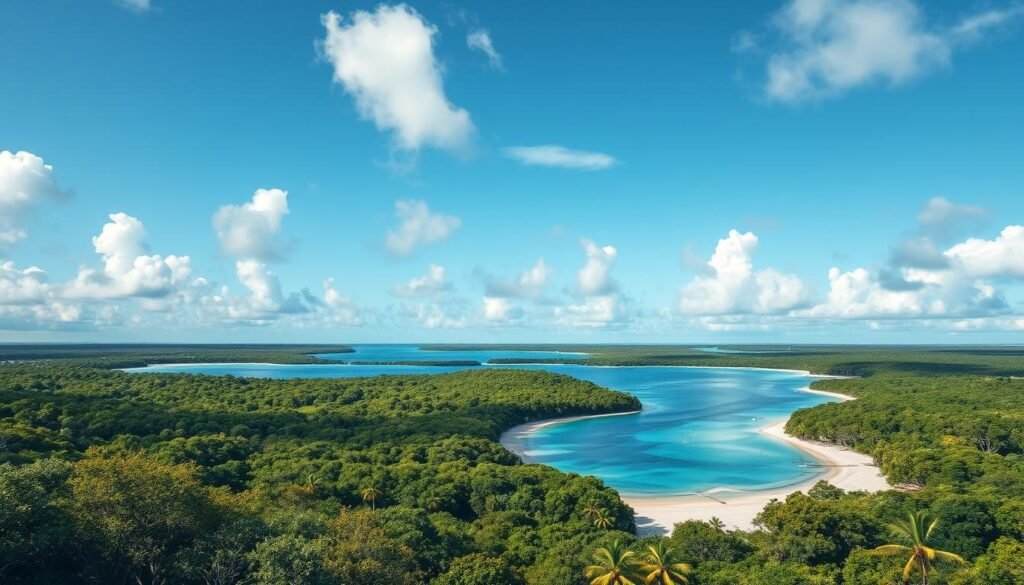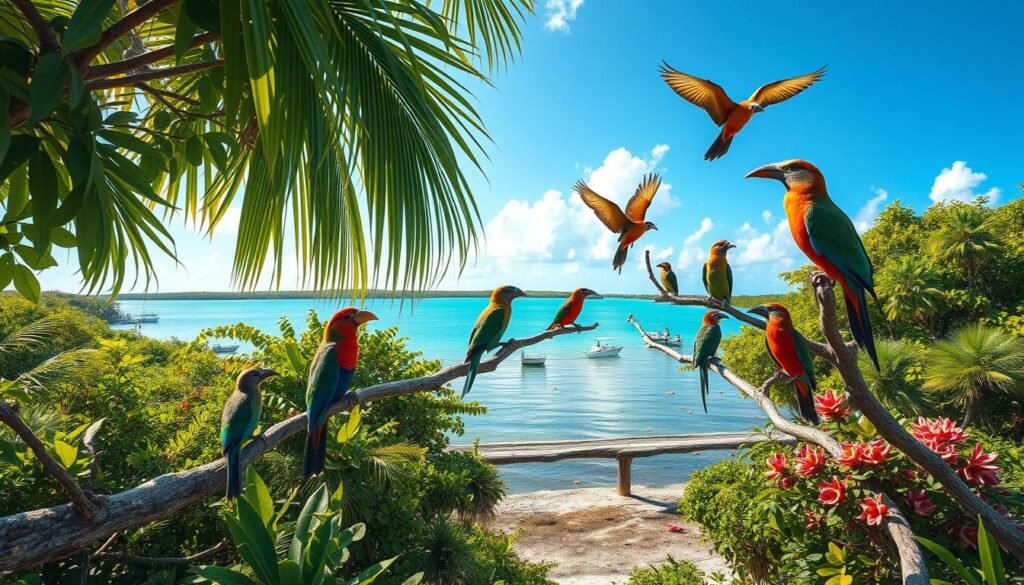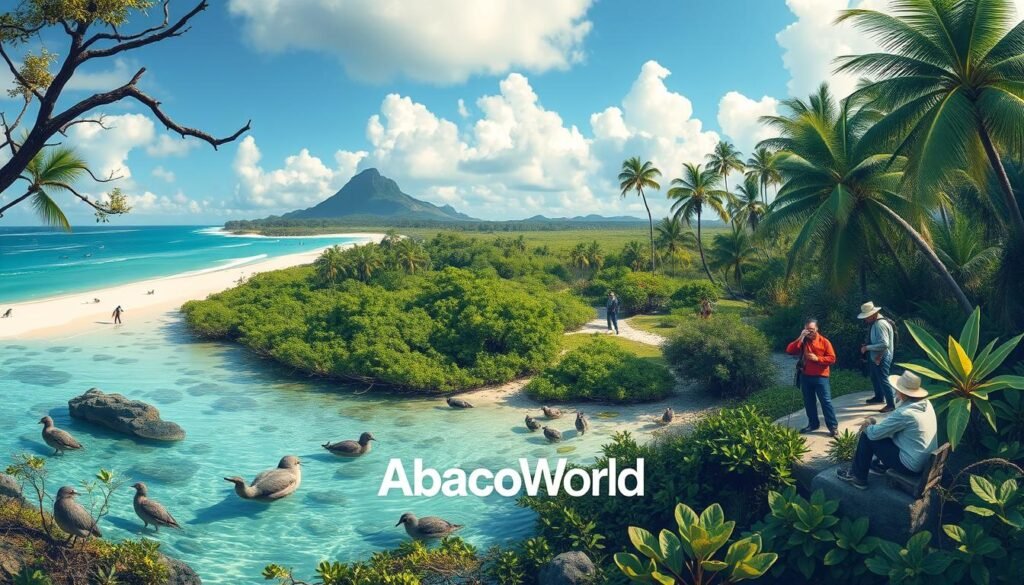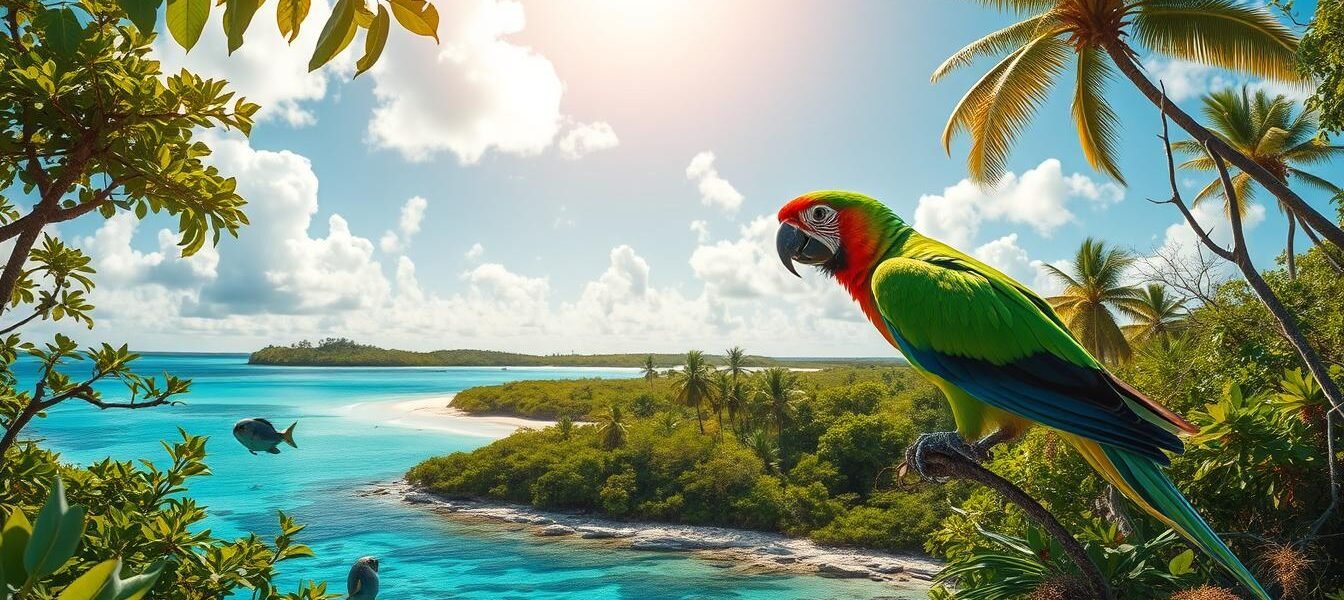“The Earth has music for those who listen.” – Shakespeare
Abaco National Park is a treasure in The Bahamas. It’s not just a home for wildlife but a place of natural wonders. Since 1994, it has been a 20,500-acre haven with forests, wetlands, and beaches. It’s key for biodiversity conservation, protecting the Bahama Parrot and over 200 bird species1.
People come here for eco-tourism and nature photography. Every year, about 50,000 visitors enjoy the park’s beauty1.
Here, you can see the success of conservation efforts. The Bahama Parrot population has grown thanks to breeding programs. The park also offers hiking and birdwatching, making it perfect for outdoor lovers. Visit Abaco National Park to help preserve our planet’s wonders.
Key Takeaways
- Abaco National Park spans over 20,500 acres of rich ecosystems.
- The park is crucial for the conservation of endangered species, particularly the Bahama Parrot.
- Visitors can enjoy a variety of outdoor activities, including hiking and birdwatching.
- The park welcomes around 50,000 visitors annually, highlighting its popularity.
- It serves as a hub for biodiversity with over 200 species of birds.
Introduction to Abaco National Park
Welcome to the breathtaking Abaco National Park, a stunning nature reserve in the Bahamas. It covers over 20,500 acres of lush forest. This park is key in protecting the Bahama Parrot’s home, hosting about 1,000 of these birds2.
The park is about 32 square miles of diverse pine forests. It’s a birdwatcher’s dream, with 213 bird species calling it home3.
As you explore, you’ll find rich biodiversity at every step. The park’s location on Great Abaco Island attracts nature lovers worldwide. It offers coastal wetlands and tropical forests to discover.
Come see the enchanting wonder of Abaco National Park. Adventure awaits at every corner.
History of Abaco National Park
The story of Abaco National Park shows the hard work in saving wildlife and nature. It was set up in 1994 to help the Bahama Parrot, whose numbers were falling fast. People from the community played a big role in its creation, fighting to save their homes.
The Creation and Purpose of the Park
Abaco National Park covers 20,500 acres and has many goals. It protects the environment and helps species like the Bahama Parrot. Thanks to efforts like these, the parrot’s numbers have grown from about 1,500 to nearly 9,000 today.
Significance of the Bahama Parrot
The Bahama Parrot is a key symbol of the park. It’s important for both the culture and nature of the Abaco Islands. The park was made to protect it, especially because of its special nesting habits.

Visiting Abaco National Park helps keep the conservation work going. It helps protect this important place for the future. For more on this beautiful place, check out this link to see what Abaco has to offer4.
Geographical Location of Abaco National Park
Visiting Abaco National Park takes you to Great Abaco Island in the Bahamas. It spans 20,500 acres (83 km²), a big area for many species and habitats5. The park’s location at 25°57′57.6″ N, 77°12′10.8″ W offers breathtaking views of the Caribbean blue waters and lush tropical landscapes5.
Your visit here lets you explore different environments and support conservation. The park is home to many unique species, like the endangered Bahama Parrot, making it very important for nature5.
The Sawmill Sink Blue Hole in South Abaco is special. It connects to a huge underground lake, showing the area’s geological and ecological past6. The park’s location guides you to see areas shaped by nature and humans over time.
Your trip to this national park is rewarding, mixing fun with nature care. By visiting, you help protect the park’s ecosystems. Don’t miss the chance to see Abaco National Park’s beauty, a gem in the Bahamas.
Ecosystems within Abaco National Park
The ecosystems in Abaco National Park are a mix of diverse habitats. These include lush pine forests and vibrant coastal wetlands. This variety supports a wide range of wildlife, making the park an ecological treasure.
The 5,000 acres of pine forests are crucial for many species. The Bahama Parrot, for example, finds important nesting grounds here7. These ecosystems are filled with life, essential for the breeding and survival of many bird species. They contribute to biodiversity in the region.
Diverse Habitats: Pine Forests and Coastal Wetlands
Pine forests in the park offer a unique environment for various species. These forests have many ecological functions. They purify the air, store carbon, and provide food and shelter.
Coastal wetlands also play a key role in maintaining the region’s health. They act as natural filters, purifying water and trapping pollutants. They are also a breeding ground for marine life, supporting the local fishing industry8.
The Role of Coral Reefs and Mangroves in Ecosystems
The coastal areas around Abaco National Park have vital coral reefs and mangrove forests. These ecosystems are not just beautiful; they are crucial for marine diversity. Coral reefs serve as nurseries for many fish species, ensuring their populations continue.
Mangroves protect shorelines from erosion, providing habitats for various wildlife. They also act as carbon sinks9.

Flora and Fauna of Abaco National Park
Abaco National Park is a key place for many endemic species. It helps keep the ecosystem in balance. The Bahama Parrot is a favorite here, showing the park’s rich wildlife.
Endemic Species: The Cherished Bahama Parrot
The park was set up in 1994 to save the Bahama Parrot. It lives in the pine forests. In 1994, there were about 1,500 birds.
Thanks to conservation, like the Predator Control Program started in 2009, there are now 8,900 birds. The park also has other unique birds, like the Bahama Yellowthroat and Bahama Warbler. It’s a great spot for birdwatching10.
Unique Flora: Caribbean Pine and Tropical Diversity
The Caribbean Pine is a key part of the park. It helps the Bahama Parrot and supports many other species. This variety of plants is important for the ecosystem’s health.
It helps prevent soil erosion and supports local wildlife. The park’s tropical plants make it special for nature lovers and scientists7.
Bird Watching Adventures in Abaco National Park
Welcome to a birdwatching paradise in Abaco National Park. Here, you can see many Abaco National Park wildlife species. It’s a place where nature lovers can have an amazing time watching different bird species.
The park has different habitats. These are perfect for many birds. So, it’s a great spot for bird watching.
Top Bird Species to Observe
In Abaco National Park, you can see many interesting birds. Some common families include:
- Anatidae (Ducks, Geese, and Waterfowl)
- Columbidae (Pigeons and Doves)
- Cuculidae (Cuckoos)
- Trochilidae (Hummingbirds)
- Rallidae (Rails, Gallinules, and Coots)
- Scolopacidae (Sandpipers and Allies)
- Laridae (Gulls, Terns, and Skimmers)
Some famous birds you might see are the Cuban Parrot, Bahama Woodstar, and Tricolored Heron. You can watch them nest and forage in places like mangroves and Carey’s Pond11.
Best Times for Birdwatching Activities
The best times for birdwatching are in spring and fall. This is when many bird species migrate through the park. Early mornings and late afternoons are the best times to see birds. They are more active then.
Seeing birds interact and behave is part of the fun. To plan your trip, check out this guide.

Outdoor Activities Available in Abaco National Park
Abaco National Park is a paradise for outdoor lovers. It offers many ways to enjoy nature, from peaceful hikes to exciting water sports. There’s something for everyone here.
Exploring Hiking Trails
The park has several unmarked trails for hiking. These paths take you through pine forests and along the coast. You’ll see untouched beauty and maybe even iguanas and birds.
Each trail shows a different side of nature. It’s a great adventure for anyone who loves the outdoors. For more info on these trails, check here.
Water Activities: Snorkeling and Kayaking
Abaco National Park is also famous for snorkeling and kayaking. The warm, clear waters are perfect for seeing marine life. You’ll see tropical fish and coral formations as you explore.
The park’s underwater world is full of reefs and blue holes. These spots are great for diving and show off the Bahamas’ unique sea life. These activities let you see the park’s beauty up close. For more on what to do here, visit here.
| Activity | Description | Best Time |
|---|---|---|
| Hiking Trails | Unmarked paths through pine forests and coastal areas. | Early morning or late afternoon for cooler temperatures. |
| Snorkeling | Explore vibrant marine life and coral reefs. | Year-round, with the best visibility from June to November. |
| Kayaking | Paddle through stunning coastal landscapes. | Year-round, early mornings for calm waters. |
Abaco National Park is a top spot for nature and adventure in the Bahamas. It offers many outdoor activities. Come and explore the park’s beauty and peace12.
Photography Opportunities in Abaco National Park
Abaco National Park is a dream spot for photography lovers. It offers stunning views and unique wildlife. The park’s varied landscapes, from vibrant pine forests to breathtaking coastlines, are perfect for nature photography.
You can take both close-up wildlife shots and wide landscape photos. This makes it a great place to capture unforgettable moments.

Capturing the Beauty of Nature and Wildlife
Photographers have many spots to explore in the park. Some areas might have fees for photography, so it’s good to plan ahead13. You can find top spots like Exuma Cays Land & Sea Park and Graham’s Harbour13.
The park is easy to find, located at 25.9544° N, 77.2063° W. You can drive there or take public transport, which costs about $2-5 per person14.
While exploring, look out for unique wildlife. You might see Bahama parrots and migratory birds. The walk to the park entrance is about a mile from the drop-off point for public transport, offering more chances to capture the scenery14.
Visitor Information for Abaco National Park
Planning your visit to Abaco National Park means knowing how to get there and when to go. The park is easy to reach with different transportation options. This makes your trip both fun and convenient.
How to Access the Park
You can get to the park in several ways, like local transport or guided tours. Many people choose local guides for their expert advice on the best paths. The park’s huge size of 20,500 acres makes a good guide very helpful15.
Public buses and taxis are also available nearby. They make it easy to get to the park. Booking a tour that includes transport is a great way to see everything the park has to offer.
Best Times to Visit and Visitor Etiquette
The best time to visit is from November to April. The weather is cool and perfect for outdoor fun during these months16. It’s also the best time for enjoying warm days with cool breezes.
It’s important to follow visitor rules to keep the park beautiful. Here are some key tips:
- Stay on designated trails to protect the environment.
- Respect wildlife by keeping a safe distance and not feeding them.
- Carry out any trash to keep the park clean.
- Be mindful of noise levels to not disturb the natural peace.
Abaco National Park is a special place for visitors to see nature’s beauty. By planning well and being careful, your visit can help protect this amazing place.
| Visitor Statistics | Percentage |
|---|---|
| Visitors coming for vacation | 76% |
| Visitors influenced by beaches | 57% |
| Visitors using online services for bookings | 65% |
“The experiences in Abaco National Park are not just visits, but journeys into the heart of nature.”17
Conservation Efforts in Abaco National Park
The Abaco National Park is a key place for protecting endangered species, like the Bahama Parrot. It covers over 22,500 acres and is home to a large number of Bahama Parrots. Thanks to conservation work, the parrot population has grown from about 5,100 in 2008 to over 8,800 in 2016, a 60% increase18.
Restoration and predator control programs help keep these birds safe. This shows how important it is to protect wildlife.
Protecting Endangered Species and Their Habitats
Conservation efforts also focus on other species. Mangrove ecosystems are crucial for marine life and are nurseries for 80% of seafood, like conch and grouper19. Friends of the Environment is working hard to protect these areas, including East Abaco Creeks National Park and the proposed South Abaco Blue Holes National Park19.
The tidal creek areas with mangroves are vital for the ecosystem’s balance.
How Visitors Can Support Conservation
You can help during your visit to Abaco. Follow park rules and practice responsible tourism. This means not disturbing wildlife and not littering.
Joining local conservation projects or volunteering can make a big difference. You can also support organizations like FRIENDS and donate to wildlife protection programs. More information is available on their website.

Importance of Abaco National Park to the Bahamas
The Abaco National Park is key to the Bahamas’ economy. It boosts local economies through eco-tourism. This area attracts thousands of visitors yearly, bringing in a lot of money for nearby towns.
Local businesses grow as more tourists come to see the park’s beauty. This is thanks to eco-tourism.
Economic Impact of Eco-Tourism
The park spans over 20,500 acres of pine forest. This offers many chances for tourism and fun activities that help the local economy20. A small entry fee of about $5 per person helps bring in visitors from all walks of life20.
Membership in the Bahamas National Trust starts at just $30. It gives members access to national parks. This encourages more people to enjoy the park’s beauty and helps fund conservation20.
Cultural and Historical Significance
Abaco National Park is more than a nature spot. It shows the Bahamas’ cultural heritage and the ties of local communities. Archaeological finds across the park remind us of the area’s deep history.
It teaches visitors about the need to protect the land and the stories tied to it10.
| Aspect | Details |
|---|---|
| Size of Abaco National Park | 20,500 acres |
| Entry Fee | $5.00 per person |
| Membership Fee | Starting at $30 |
| Economic Influence | Boosts local businesses through eco-tourism |
| Historical Importance | Home to archaeological remains and cultural heritage |
Unique Attractions Within Abaco National Park
Abaco National Park is a treasure trove of unique attractions. It invites adventurers and nature lovers to explore. You’ll find hidden paths and breathtaking landscapes.
Signature Trails and Pathways
The park’s rustic pathways are perfect for those who love nature. A highlight is the trek to the “Hole-in-the-Wall” lighthouse. This journey is 15 miles long and offers stunning views and history.
Noteworthy Landmarks and Natural Features
The park boasts diverse landscapes like rocky shores and dense pine forests. It’s a haven for wildlife, including the Bahama Parrot. Thanks to conservation, the parrot population is thriving.

| Unique Attractions | Details |
|---|---|
| Hole-in-the-Wall Lighthouse | A historic lighthouse accessible via a 15-mile dirt trail, showcasing the park’s natural beauty. |
| Bahamian Pine Forests | Home to unique ecosystems and the primary habitat for the Bahama Parrot, covering 5,000 acres. |
| Rocky Shorelines | Provide stunning backdrops for wildlife and photography enthusiasts, enhancing exploration opportunities. |
| Rare Habitats | Preserve the biodiversity of the region, making it essential for local wildlife and conservation efforts. |
Exploring Abaco National Park is truly enchanting. Its trails and landmarks tell a story of nature’s beauty and preservation in the Bahamas1054.
Keeping Abaco National Park Pristine
Abaco National Park’s beauty and health depend on strict park rules and careful preservation. These rules help protect the wilderness and let visitors enjoy it responsibly. By following these guidelines, you help keep this special place safe for future generations.
Park Regulations and Preservation Methods
Many rules are in place to reduce human impact and keep wildlife safe. Always stay on marked paths and keep a distance from animals. Important preservation steps include:
- Enforcing laws to protect wildlife
- Restoring habitats for species like the Abaco parrot
- Teaching visitors how to care for the environment
Thanks to these efforts, the Abaco parrot population has grown to around 4000. This is a big win for the park’s biodiversity, especially since they are the only ground-nesting parrots in the Bahamas21.
By following park rules, you can help protect the wilderness. Choosing eco-friendly activities and joining guided tours reduces harm to the environment. This supports the park’s conservation goals.
Experiences and Testimonials from Visitors
Abaco National Park is a place of beauty and life, where visitors find unforgettable moments. The park’s lush landscapes and vibrant wildlife create a deep connection with nature. This connection is something people remember for a long time.
What Makes Abaco National Park Special to Travelers
People love the park’s untouched beauty and the chance to see rare birds like the Bahama Parrot. The park covers over 20,500 acres, filled with pine woods and diverse wildlife215. Birdwatching here is a highlight, with over 200 species to spot22.
The calm of the park invites visitors to reflect, making their visit a memorable one.

Travelers praise the park for its role in protecting habitats and supporting conservation. They wish for more protection to help the Bahama Parrot thrive beyond Abaco2. The real wildlife encounters and stunning views keep visitors coming back.
The Future of Abaco National Park
The future of Abaco National Park looks bright. Projects and initiatives are underway to protect its wildlife and involve the community. You can help make sure the park remains a treasure for generations to come.
Ongoing Projects and Environmental Initiatives
New protected areas are being set up in Abaco. Four national parks now cover different ecosystems. For example, East Abaco Creeks National Park protects about 13,000 acres of wetlands23.
South Abaco Blue Holes National Park is even bigger, covering around 34,000 acres. It houses important cave systems for many species23.
Education and community involvement are key. Programs aim to teach locals and visitors about protecting wildlife. This includes the unique ecosystems of Abaco, like pine rocklands and coral reefs24.
Conservation efforts are already showing results. Over 3,000 bonefish have been tagged for research in Abaco23. These projects show how science can help both tourism and the environment. They also show a commitment to sustainability, helping both wildlife and local communities.
Conclusion
Abaco National Park is a true marvel of nature and a key spot for those who love the outdoors. It covers over 20,500 acres and is home to more than 100 bird species, including the rare Abaco Parrot. You’ll find pine forests and mangrove wetlands here too25.
Since 1994, the park has been a safe haven for many animals. It shows how important it is to protect the Bahamas’ natural world25.
Visiting Abaco National Park lets you see amazing landscapes and learn about nature. You can go birdwatching, hiking, or just enjoy the scenery26. It’s a great way to help protect the environment.
By choosing eco-friendly tourism, you support important conservation work. This helps make the park a better place for everyone26.
Exploring the park, you’ll see its dedication to protecting its creatures and offering a peaceful escape for nature enthusiasts. Let’s work together to keep Abaco National Park thriving for future generations27.
FAQ
What activities can I do at Abaco National Park?
When is the best time to visit Abaco National Park?
How does Abaco National Park contribute to wildlife conservation?
What should I know about visitor etiquette in the park?
Are there guided tours available for exploring Abaco National Park?
What kind of wildlife can I expect to see in Abaco National Park?
How can I support conservation efforts while visiting?
Are there any notable landmarks within the park?
Is there an entrance fee for Abaco National Park?
Source Links
- https://evendo.com/locations/the-bahamas/abaco-islands/landmark/abaco-national-park
- https://www.nationalparkstraveler.org/2019/01/discovering-abaco-parrots-bahamas
- https://caribbeanbirdingtrail.org/sites/bahamas/abaco/
- https://rollingharbour.com/conservation/abacos-national-parks/
- https://www.globalnationalparks.com/bahamas/abaco/
- https://www.abacopalms.com/south-abaco-blue-holes-national-park-established-august-31-2015/
- https://www.friendsoftheenvironment.org/protected-areas
- https://bnt.bs/news/kakona-development-poses-existential-threat-to-national-parks-in-south-abaco/
- https://www.cbd.int/doc/meetings/fin/rmws-2015-01/other/rmws-2015-01-presentation-03-en.pdf
- https://bnt.bs/explore/abaco/abaco-national-park/
- https://fieldguides.com/triplists/bah23.html
- https://sunsetpointabaco.com/activities/
- https://bnt.bs/explore/what-do-you-want-to-do/photography/
- https://evendo.com/locations/the-bahamas/abaco-islands/attraction/abaco-national-park
- https://www.tourtravelworld.com/bahamas/abaco-islands/abaco-national-park.htm
- https://www.tourismtoday.com/sites/default/files/docs/stats/AbacoBrochure2011.pdf
- https://www.myguidebahamas.com/things-to-do/national-parks/abaco-chain
- https://www.birdscaribbean.org/2018/05/post-irma-parrots-in-the-abaco-pinelands-are-holding-their-own/
- https://coastalanglermag.com/habitat-conservation-efforts-continue-in-abaco/
- http://www.thebahamasweekly.com/publish/service-clubs/The_Ultimate_Summer_Vacation_6_Parks_on_One_Island36295.shtml
- https://rollingharbour.com/birds/abaco-parrots/
- https://www.notesfromtheroad.com/westindies/abaco-islands.html
- https://rollingharbour.com/conservation/new-protected-areas/
- https://dragonflyworkshops.miamioh.edu/eportfolios/1154/sections/27286/section_attachments/40001/download
- https://travelingkangaroo.com/abaco-national-park/
- https://rollingharbour.com/wp-content/uploads/2012/06/east_abaco_creeks_national_park_proposal.pdf
- https://www.tribune242.com/news/2019/apr/24/irreversible-harm-fears-580m-abaco-project/





